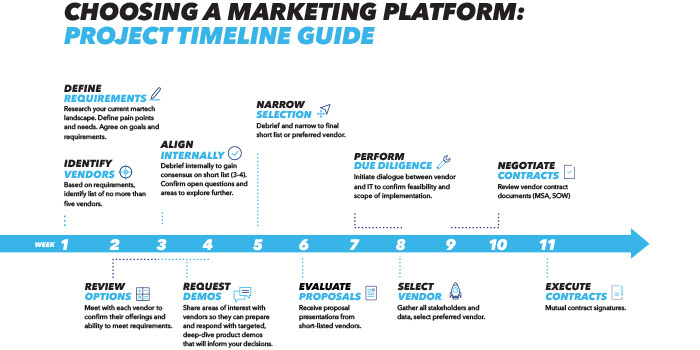

Are you happy with your digital marketing platform? Or is it time to make a fundamental change in your marketing technology stack in order to deliver more relevance and more customer-centric engagement?
With the global coronavirus pandemic pushing customer journeys further into digital channels, technology alone holds the key to understanding and engaging consumer audiences. So it’s no surprise that many brands and companies are reevaluating their marketing platforms. And today, marketers have access to more platforms than ever before. In 2020, the Marketing Technology Landscape encompassed a total of 8,000 martech solutions, an increase of 13.6 percent over 2019 in a $121 billion industry.
Choosing the right platform for your marketing needs – one that brings existing data and services full circle – is a major decision. It’s important to understand the process and to have a game plan in place before you get started.
Every journey begins by taking the first step. While the prospect of adopting a main marketing solution can be daunting, breaking the process down into individual steps makes it manageable. Clearly established timelines help keep budgets manageable. A well-defined timeline towards your go-live date also helps vendors deliver structured pricing models based on availability, and builds a clear case for internal stakeholders.
To help marketers with the process, we’ve created a realistic timeline for vetting prospective vendors and making an informed decision that involves all key stakeholders. The guide is representative of a typical marketing platform evaluation process, and while we’ve included suggested timing for each step, your actual timing may vary.
Ready to get started? Read on for some key details and considerations for each step of the process.

Research your current martech landscape to explore solutions that fit your marketing style. Define pain points and needs. Also agree on goals and requirements. The more specific you make your goals, the easier it will be to get stakeholders aligned, especially accounting. Questions that help with goal definition include:
Based on your requirements, identify a shortlist of no more than five vendors. Tapping into your own network for vendor leads is a great idea, as is monitoring social media. Doing your own research in advance will achieve two things: First, it will provide a broad overview of the general service level in your desired field. And second, you will develop a first idea of the vendors best suited to meet your goals.
Meet with each vendor to confirm their offerings and ability to meet requirements. Bring specific questions from stakeholders – including marketing and IT – to the meeting. Leverage additional information from independent third-party user reviews on platforms such as G2 Crowd.
Debrief internally with all relevant stakeholders to gain consensus on your vendor short list. Confirm open questions and areas to explore further.
Share areas of interest with vendors so they can prepare and respond with targeted demos that will inform your decisions. Feel free to ask questions during the demo period, also to gauge vendor SLA and helpfulness. When reviewing platform demos, perform stringent tests for data and software integration. And evaluate how the solution performs in light of the following three major pain points reported by marketers:
Debrief with your team and narrow to a final short list of preferred vendors.
Receive proposal presentations from short-listed vendors. Perform cost-benefit analysis of prospective marketing platforms. Weigh overlap of features with existing stack and savings from replacing legacy solutions.
Initiate dialogue between vendor and IT to confirm feasibility and scope of implementation. This is also a good time to address migration issues and potential timelines until launch.
Decision day! Gather all stakeholders and data, and select your preferred vendor.
Review vendor contract documents (MSA, SOW) with legal and finance teams.
Meet for mutual contract signatures to seal the deal.
Following contract execution, you’re ready for kick off! That’s a whole other process, including an initial project planning meeting with the vendor team and key stakeholders, followed by gathering assets, data layouts, finalizing solution design and requirements, laying out a detailed plan for implementing the platform build, migrating data, testing functionality, testing teams and, ultimately, launching the platform.
With more solutions in the martech landscape than ever before, and a clear trend towards connectivity, marketers are empowered to streamline their tech stacks for marketing success. Choosing your primary marketing platform will make all the difference.
Once you are ready to take the next step, our team is here to guide you through the process in a hands-on manner. And we also suggest that you grab a copy of our free eBook, 12 Strategies for a Seamless Marketing Automation Platform Migration, which details the challenges and best practices in switching from an existing set-up to a brand-new solution.
Marigold: where relationships take root.